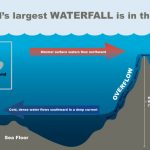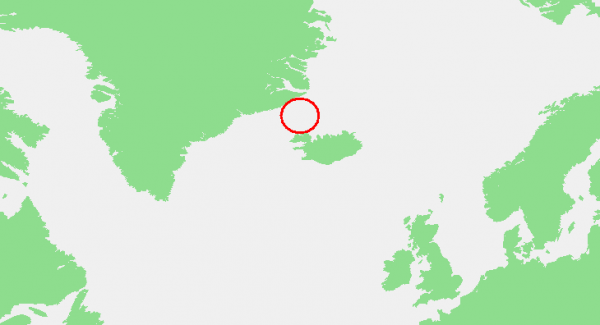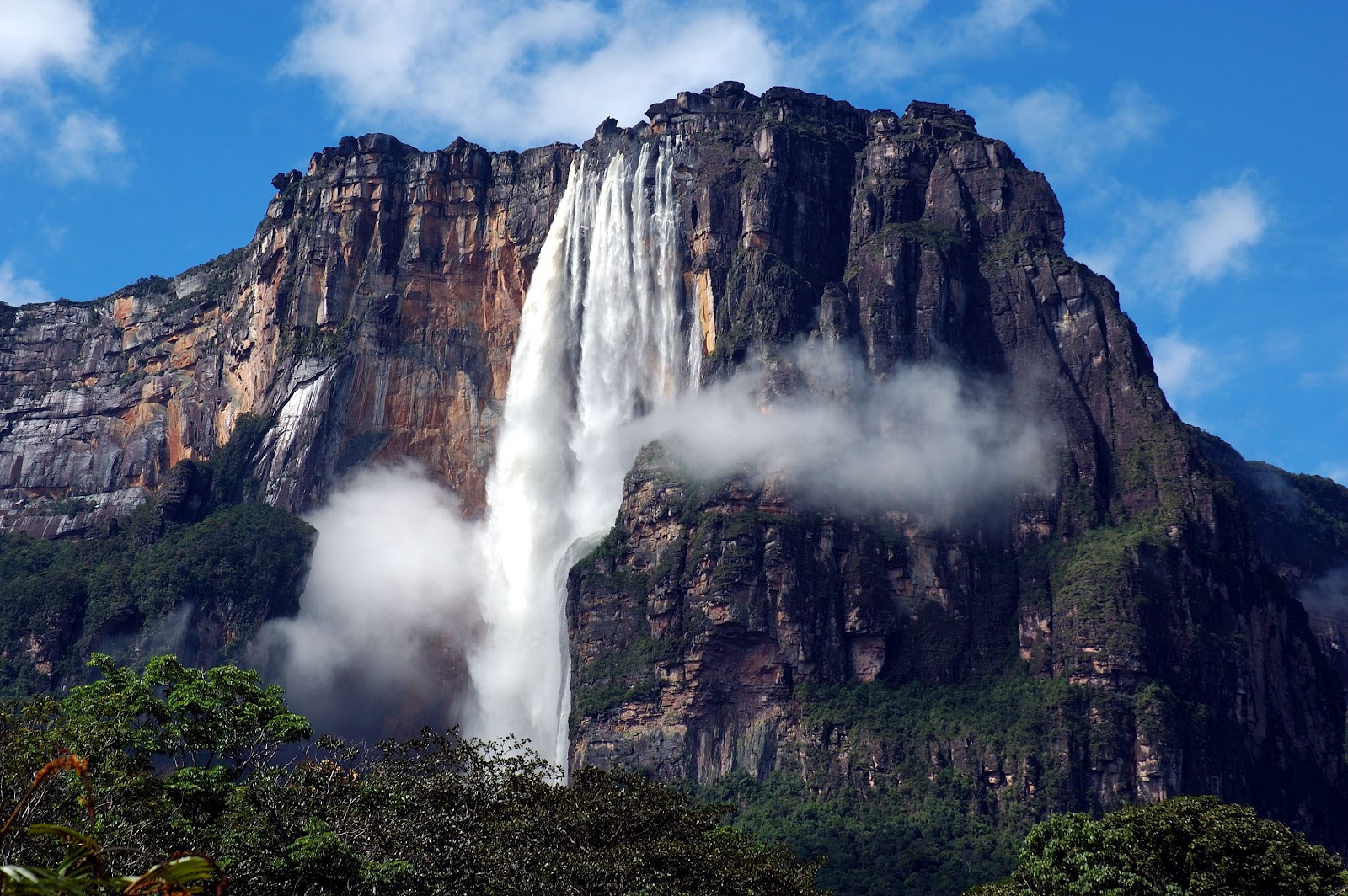

View larger. | This infographic illustrates how a large underwater cataract (waterfall) naturally forms underneath the waves within the Denmark Strait. (A map in the upper right of the graphic shows the location of Denmark Strait, between Greenland and Iceland.) Warmer surface waters flow northward. These warmer waters gradually lose heat to the atmosphere and sink. Denser, cold water flows southward in a deep current along the sea floor over an undersea ridge in the Strait. The height of the Denmark Strait cataract is approximately 11,500 feet (3,500 meters). By comparison, the largest waterfall on land is 3,212 feet (980 meters). Image via NOAA.
Rivers flowing into Earth’s gorges create waterfalls that are natural wonders, drawing millions of visitors. But Earth’s largest and most powerful waterfall doesn’t attract many tourists. That’s because it lies beneath the ocean, under the Denmark Strait, which separates Iceland and Greenland.
The waterfall – known as the Denmark Strait cataract – under the Denmark Strait near the southern tip of Greenland – begins 2,000 feet (600 meters) under the ocean surface and plunges to a depth of 10,000 feet (3,000 meters), nearly a 2-mile (3.2 km) drop.

The Denmark Strait. Image via Wikipedia.
The Denmark Strait cataract is more than 3 times the height of Angel Falls in Venezuela, which is considered Earth’s tallest waterfall (on land). And the Denmark Strait cataract carries an estimated 123 million cubic feet (3.5 million cubic meters) of water per second. That’s equivalent to almost 2,000 Niagara Falls at peak flow.

Angel Falls in Venezuela, the tallest waterfall on land, is 3 times shorter than the Denmark Strait cataract, and Niagara Falls carries 2,000 times less water, even during peak flows. Image via beautifulworld.com.
But how can there be waterfalls in the ocean? It’s because cold water is denser than warm water, and in the Denmark Strait, southward-flowing frigid water from the Nordic Seas meets warmer water from the Irminger Sea. The cold, dense water quickly sinks below the warmer water and flows over the huge drop in the ocean floor, creating a downward flow estimated at well over 123 million cubic feet (3.5 million cubic meters) per second. Because it flows beneath the ocean surface, however, the massive turbulence of the Denmark Strait goes completely undetected without the aid of scientific instruments.
When the water from the Denmark Strait cataract reaches the ocean floor, it forms a massive current traveling south, replacing warmer surface water that’s flowing north. The amount of water in this gigantic flow equals between 20 and 40 times the sum of all river water that flows into the Atlantic.
Bottom line: Earth’s largest waterfall – known as the Denmark Strait cataract – is under the ocean.
Via National Ocean Service/ NOAA
from EarthSky https://ift.tt/2C9jP4M


View larger. | This infographic illustrates how a large underwater cataract (waterfall) naturally forms underneath the waves within the Denmark Strait. (A map in the upper right of the graphic shows the location of Denmark Strait, between Greenland and Iceland.) Warmer surface waters flow northward. These warmer waters gradually lose heat to the atmosphere and sink. Denser, cold water flows southward in a deep current along the sea floor over an undersea ridge in the Strait. The height of the Denmark Strait cataract is approximately 11,500 feet (3,500 meters). By comparison, the largest waterfall on land is 3,212 feet (980 meters). Image via NOAA.
Rivers flowing into Earth’s gorges create waterfalls that are natural wonders, drawing millions of visitors. But Earth’s largest and most powerful waterfall doesn’t attract many tourists. That’s because it lies beneath the ocean, under the Denmark Strait, which separates Iceland and Greenland.
The waterfall – known as the Denmark Strait cataract – under the Denmark Strait near the southern tip of Greenland – begins 2,000 feet (600 meters) under the ocean surface and plunges to a depth of 10,000 feet (3,000 meters), nearly a 2-mile (3.2 km) drop.

The Denmark Strait. Image via Wikipedia.
The Denmark Strait cataract is more than 3 times the height of Angel Falls in Venezuela, which is considered Earth’s tallest waterfall (on land). And the Denmark Strait cataract carries an estimated 123 million cubic feet (3.5 million cubic meters) of water per second. That’s equivalent to almost 2,000 Niagara Falls at peak flow.

Angel Falls in Venezuela, the tallest waterfall on land, is 3 times shorter than the Denmark Strait cataract, and Niagara Falls carries 2,000 times less water, even during peak flows. Image via beautifulworld.com.
But how can there be waterfalls in the ocean? It’s because cold water is denser than warm water, and in the Denmark Strait, southward-flowing frigid water from the Nordic Seas meets warmer water from the Irminger Sea. The cold, dense water quickly sinks below the warmer water and flows over the huge drop in the ocean floor, creating a downward flow estimated at well over 123 million cubic feet (3.5 million cubic meters) per second. Because it flows beneath the ocean surface, however, the massive turbulence of the Denmark Strait goes completely undetected without the aid of scientific instruments.
When the water from the Denmark Strait cataract reaches the ocean floor, it forms a massive current traveling south, replacing warmer surface water that’s flowing north. The amount of water in this gigantic flow equals between 20 and 40 times the sum of all river water that flows into the Atlantic.
Bottom line: Earth’s largest waterfall – known as the Denmark Strait cataract – is under the ocean.
Via National Ocean Service/ NOAA
from EarthSky https://ift.tt/2C9jP4M

Aucun commentaire:
Enregistrer un commentaire